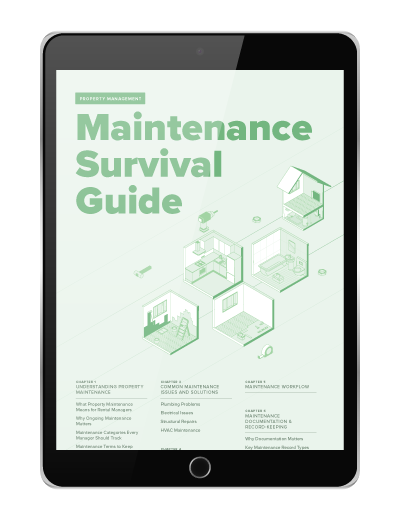According to our industry intel, only 1 in 3 rental properties are profitable, meaning the property management profit margin of most businesses is precarious at best.
Start your free trial today!
Try Buildium for free for 14 days. No credit card needed.
Start Your TrialWhat can property managers do to keep their businesses profitable?
Clear visibility into your business can help you determine where you should focus your efforts, improve on successes, and overcome specific obstacles to revenue growth. With so many variables to take care of, from finding the right tenants to bookkeeping, you’ll need a combination of business knowledge, data, and tools to achieve that visibility and strengthen your property management business model.
We’ve refined these considerations into five actionable steps you can take to achieve consistent profitability for your business, and included advice from fellow property managers to help you get deeper visibility into your profitability.
Step 1: Understand Your Overall Business Performance to Identify Growth Opportunities
- Area of Business: Overall business performance
- Visibility Tool: Data and Analytics Hub
- Benefit: Strategic planning, Engaging your team and owners
Any well-informed business decision starts with the right data. You probably already have an idea of how your company is faring, but the key to turning all that information into useful insights—and then into action—is to keep your data in one place
A data and analytics hub can help paint the whole picture of your property business —the revenue for each property, tenant turnover, and feedback from tenants. This combination of both qualitative and quantitative data helps measure business performance and identify opportunities for growth automatically.
Setting up a central repository for business insights leads to major benefits. For one, you’re able to track changes in performance over time. You can compare the revenue you’re generating from a specific property or part of your portfolio to performance a year ago, or over the past five years, for example. You can also see how that performance measures up against industry benchmarks. This all comes in handy when deciding where to look for more business and how to divide your effort between clients and properties in your portfolio.
Having a hub in place also lets you share access to vital information with team members, owners, and other stakeholders. It makes it easier to keep everyone on the same page. You can share your successes with owners in real time through an owner’s portal that outlines all the high-level financial performance of your business.
Step 2: Know Which Units to Focus Your Attention On
- Area of Business: Vacancies, turnover, and time on market
- Visibility Tool: Lead-to-Lease Management System
- Benefit: Identifying profitable and costly units, Adapting and measuring the success of leasing strategies
With big picture trends in mind, it’s time to get more granular. If you see red flags in any specific properties, you’ll want to be able to find out what’s causing losses in revenue and how deep rooted any issues are.
Often, this comes down to extended vacancies and shorter than expected leases caused by evictions or any other type of early lease terminations. To take action, you first need to know which units are staying vacant and how long they’ve been on the market. The leasing history for those units adds much needed context and helps you to make the changes needed to get those units filled.
This is where a comprehensive lead-to-lease management system comes in. This kind of system stores records at each stage of the leasing process, from the point of listing a unit, through the application and signing process, and all the way to the termination or renewal of a lease. The result is a detailed timeline of every property, unit, and lease.
Using a lead-to-lease management system you can study your all-star units—the ones that draw in the most applicants whenever they’re listed and have a history of satisfied, long-term tenants—and see what you can apply to your more troublesome units. It could involve changing up amenities or adjusting rent. Maybe it’s a new marketing strategy. The point is you know where to put your focus and how to track the success of whatever efforts you make.
“Excel spreadsheets are a terrific tool—until they’re not. They don’t tell a story. When we dig into a specific Buildium report, we’re looking for that story to be told of why this person did not pay and that just wasn’t possible before that report became available to us [and we] adopted that software.” – Ian Stahl, Stahl Enterprises
Step 3: Understand Where Your Current Rental Property Profit and Losses are Coming From
- Area of Business: Bookkeeping, payments, and delinquencies
- Visibility Tool: Online, Industry-Specific Accounting Software
- Benefit: Fewer missed payments, Faster resolution to challenges with delinquencies
Taking visibility a step further involves some number crunching, but don’t worry, you won’t even have to reach for a calculator. In fact, with each calculation your team makes manually, the door to human error and oversight opens a little bit wider.
Accurate bookkeeping is necessary to understanding cash flow, calculating ROI, and lowering taxes. Purpose-built accounting software for property management gives you the level of granularity, accuracy, and customization you need to not just stay compliant and in the black, but also grow your revenue.
This software puts your chart of accounts in one place, creating a high level overview of both revenue and expenses for every account of your business. Having a single source of truth—where all your financial data is stored in an easy-to-manage accounting system flows through in one location—lets you get as granular as you want with your data, while also being able to pan out to see the full picture.
You can customize your chart of accounts in Propertyware which allows us to give owners more information. It also allowed us to be able to track more of where our profits and expenses are coming from by using those custom GLs.
“We have what we call Zero-Gap accounting and we have two custom reports for the previous month and current month which a client can click on and see exactly what’s going on. It’s not an exact P&L of the statement, but it’s really close. Then, they get the monthly statements, so they can always know what’s going on with their portfolio.”– Drew Sygit, Logical Property Management
The right property management software can help track online rent payments and automate bank reconciliation, so your numbers always add up. From here, you can identify specific rent payment patterns that affect your bottom line. That includes spotting delinquencies. With payment history in hand, you can have informed conversations with tenants to uncover and resolve issues around missed payments. You can also use your software to send automated and customizable emails or physical mail that remind tenants of upcoming rent or past due notices.
Automation can even help you avoid delinquencies all together. Processing online payments and automatically collecting late fees can help encourage future on-time payments.
Step 4: Reassess Your Maintenance Vendor Relationships
- Area of Business: Vendor performance and maintenance patterns
- Visibility Tool: Vendor Management System
- Benefit: Higher quality repairs, Avoiding money pits
Sometimes obstacles to profitability are less direct than a vacant unit or delinquent payment. To find these issues, you’ll have to look at other areas of your business. One of the most important is your process for managing maintenance and repairs.
Over the years, you may have built up a strong working relationship with certain vendors. On the other hand, you might choose contractors for some jobs out of convenience or expediency, rather than a proven track record. Either way, a vendor management system within your property management software ensures that you’re getting quality work and the most value for your money.
A platform that goes beyond storing vendor information to track the entire work order process, from request to payment and completion lets you keep tabs on how quickly a particular vendor can tackle a repair, and what exactly that repair was. You’ll know who to call when a similar issue pops up again.
On the other hand, you’ll also know when and how often a vendor, or multiple vendors have to come back to a property to fix the same problem. This can clue you into a particular unit or appliance that’s becoming a money pit, or even a vendor whose work might not be up to par.
The next step is simple. With detailed records at the ready, you can renegotiate contracts, assign vendors you can rely on, find a new vendor, replace an appliance, or talk with owners about more extensive repair work to a unit or overall maintenance costs for a property.
You might be able to spot issues here and there without these vendor management tools, but with them, you’ll have peace of mind knowing you’re running an airtight, well-maintained ship.
Step 5: Generate Revenue with New Services
- Area of Business: Residential services and fees
- Visibility Tool: Industry Research, Surveys, and Marketing Tools
- Benefit: Introducing profitable new services that renters love
By this point, you have tools in place to determine where you’re losing money and even ways to make your existing relationships and operations more profitable. Now, let’s discover how to explore net new sources of revenue.
One of the most successful and flexible ways to create a new source of revenue is by introducing new resident services. These services can range from more storage space on a property to the ability for rents to report on-time payments and boost their credit score. However, with so many options, how do you choose the ones that will have the greatest impact on your bottom line?
As a starting point, you can brush up on research on renters preferences such as Buildium’s Property Management Industry Report. With those general trends in mind, you can also conduct surveys and other forms of outreach to your existing tenants. Technology such as an online communication center makes this easy to coordinate and non-intrusive for your residents.
Take advantage of the visibility tools you’re already using for accounting and business intelligence to look across your portfolio and spot the services that are already working for high-profit properties. Consider introducing them to other properties with the potential for greater revenue.
Once you’ve added amenities and launched new services, get the most mileage out of them by marketing them in your listings and in your pitches to prospective clients. You can use whatever feedback you receive to fine-tune your service offerings over time.
Read more in our guide on 15 ways to generate property management revenue when portfolio growth isn’t an option.
Start Growing Your Profit Margins
Having a pulse on your revenue numbers isn’t enough to run a profitable business. The more you know about where your business is suffering and thriving, the more proactive you can be in growing it.
Whether it’s streamlining your lead-to-lease cycle with technology or customizing your business performance reports to understand your expenses, property management software tools such as those included in Buildium can help you increase visibility and profitability in your property management business.
Not a Buildium customer? Get started with a 14-day free trial today – no credit card required.
Read more on Growth

